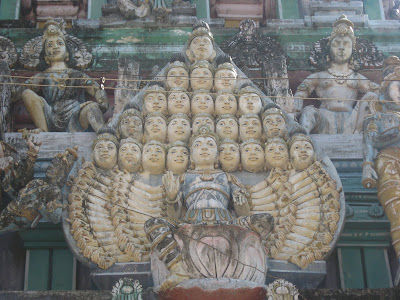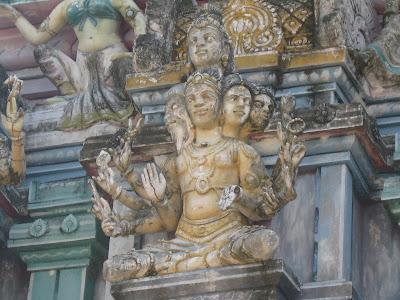Memory is unpredictable . One never really knows what we will remember and what we will forget. Which is why nostalgia arrives in unpredictable waves, highlighting something and skimming over others. Recently, I have found myself thinking of how memory works, as I was assailed by nostalgia over a trip to Varanasi, a city I prefer to think of, as Kashi. The nostalgia hit right as we landed at Varanasi airport. The last time I was here, it was 1988, I was 13 years old, the airport was brand new… regular flights hadn’t started yet (I think) … flights landed about once a week, and for the rest of the time, everything was open to those of us who lived in the airport quarters nearby. There were fields everywhere, vast expanses of green… I have vague memories of corn and sugarcane… and being overwhelmed by the vastness of the fields (this was the first time I was in such close proximity to them), and the warm hospitality of complete strangers who lived and worked amidst these fields. I h...
Of all the temples we visited during our ten-day trip, this is one temple that stands out in my memory like no other. While I shall think of the Brihadeeshwara temple at Tanjore with appreciation for the beautiful architecture, and Dharasuram for the beauty of sculptures, Nallur, or Thirunallur, is one of those temples where I truly felt the presence of God. This temple is about 10 Kms from Kumbakonam, and just 10 minutes from Patteeswaram.
 |
| From Diwali 08 - Thanjvur Trip |
As we alighted from the car at this temple, I was arrested by the beauty of the Gopuram. The detail was amazing, and the deities depicted were fantastic! Here are a couple of photographs I took of the deities depicted on the Gopuram. While the first one I learnt later was Maha Sadasiva Moorthy, one of the 64 forms of Shiva, I haven’t been able to understand the second. If anyone knows the name of the deity, please do let me know.
 |
| From Diwali 08 - Thanjvur Trip |
 |
| From Diwali 08 - Thanjvur Trip |
As we entered the temple, we realized that we were in one of the Maada Kovil or Yaanai Eera Kovil, which means that the main sanctum is situated at a higher level, accessible by steps, which cannot be climbed by elephants. These were temples built by Kochengattan Cholan, and the root of this story lies at Thiruvanaikaaval, in Trichy. According to the legend, at Thiruvanaikaaval, a spider and an elephant both prayed to Shiva, in their own way. While the elephant poured water on the lingam in the day, the spider covered the lingam with its web in the night. Every morning, the elephant would be angry to see the spider webs on the lingam he had cleaned the day before, and the spider would be angry to see the web destroyed every morning. Finally, when they both left their bodies and passed on, the spider was born as a king, and remembered his past life. He spent his life building temples where elephants would never be able to enter the sanctum. While his motives in building such temples may be debatable, there is no doubt that every temple he built is beautiful, and gives pleasure to the visitor. Other temples built the same way are at .Kudavasal, Nannilam, Chaayavanam, Thalaichangadu, Valivalam, Ambar (Ambal) and Thiruveezhimizhalai
When we entered the temple, we might have missed the steps, had it not been for the priest, who called out to us. The entrance is near a beautiful idol of Ucchishta Ganapathy – Ganesha with Neela Saraswati on his lap – a rare idol.
The main deity is Kalyana Sundarar, for Shiva is believed to have granted Sage Agasthya a vision of his marriage here. Behind the lingam are the images of Shiva and Parvati shown getting married, with Brahma performing the rites of marriage on the left, and Vishnu, giving away his sister Parvati in marriage, on the right. The lingam itself is unique, for it is made of an unknown material and changes colours five times a day, and is thus also known as Panchavarneswarar. The lingam has 3 portions – the lower portion which joins the Avudaiyar, and is smooth, the middle portion, which is rough, and the top, which is again smooth, and is the most prominent part of the lingam. Each of these parts changes colour every 2 ½ hours. We were in the temple for about a half an hour, and we could sense the slight change in colour even in that short time. If you plan to visit the temple, give yourself at least 3 hours for this temple alone, so that you can really see the colour changes. To aid you all, I have taken a photo of the notice on the temple wall indicating the colours of the lingam at various times.
 |
| From Diwali 08 - Thanjvur Trip |
For those like me, who are not well versed in Tamil, here is the same information, in English.
From sunrise to sunset, the colour of the top portion of the lingam changes every 2 ½ hours as follows:
6AM to 8:24AM – Copper colour
8:25AM to 10:48AM – Light Red (the colour of sunrise)
10:49AM to 1:12PM – colour of molten gold
1:13PM to 3:36PM – Emerald green
3:37PM to 6PM – an indescribable colour, sort of mixed.
The middle portion alternates between shades of blue and green. This part is somewhat rough and seems pock-marked.
The lower portion remains black at all times.
The saint Appar is believed to have prayed for surrender at the lord’s feet at both Patteeswaram and Thirushaktimuttram. He was asked to come to Nallur, where he finally got his wish. Commemorating Appar’s surrender at the deity’s feet, the practice of placing an icon containing the imprint of the deity's feet on the heads of devotees is carried out here like in Vaishnavite temples. The goddess here is called Kalyana Sundari or Giri Sundari, and has her sanctum immediately outside the sanctum of the lord.
The temple priest, Kannan Gurukal, was most helpful, telling us about the temple, its history, and the kind of pujas performed. I was so impressed by the temple, especially the main deity and the images behind the lingam, that I asked him if I could take a picture to show my mother, who would have loved to have visited this temple. To my astonishment, he said something totally unexpected. He said that the temple and the deity had been photographed a number of times, for articles in magazines, newspapers etc. When he could allow professionals to photograph the deity, there was no point in refusing amateurs like me. When I further asked him if I could publish the photographs, he told me that the photograph of the deity had already appeared in a popular Tamil magazine and in the local papers too. It really wouldn’t matter if I also published it. In any case, he added, if it resulted in more people visiting the temple, it would only be for the best. It was completely dark inside the sanctum, for there was no electricity, and we were only able to see the images behind during the deeparadhana. He asked me if my camera would be able to capture the images inside under such conditions. I replied that I would try, and would use the photographs only if they turned out well; I would leave the decision of whether the photos were to be published to Him – he who was the most concerned in the matter. The results are here for all of you to see.
 |
| From Diwali 08 - Thanjvur Trip |
This is one temple I shall certainly not forget, and would recommend to anyone remotely interested in temples.
Very good write up about this little known temple. Lots of interesting tidbits....especially about the lingam changing colors.
ReplyDeleteI liked the write up. I stumbled upon this site when I was looking for information about this temple. I belong to this village. Though I know the information given here your presentation is good. I am writing a book on this temple. Recently one of the TV covered this temple in their morning broadcast. All the best wishes for more writing and visits to temples
ReplyDeleteI have posted this write in the yahoo group of Nallur Citizens in july 2014
Deletehttps://groups.yahoo.com/neo/groups/Nallurians/conversations/messages/4
Sundararajan
Thanks for the detail write up.Sitting in KBKm,I chanced to go through ur blog and got very much impressed.Let me try to see the temple today as I return back to chennai in the afternoon.Such blogs are very helpful in enlightening others and may God be with you always.
ReplyDeleteV V Balakrishnan-Hyderabad
ReplyDeleteVery informative, thanks for posting such informative content. Expecting more from you.
Tamil Matrimonial Services